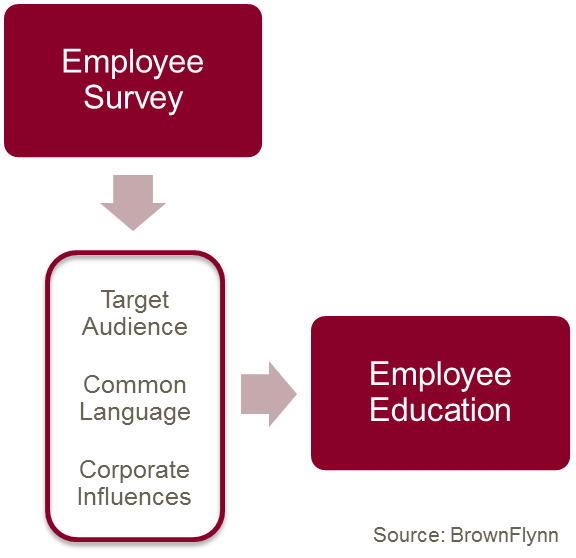 |
| Reviews and Templates for Expression We |
How to embed sustainability within your workforce

Editor's note: The first part of this series focused on increasing employee engagement on sustainability.
This is the second installment in a three-part series on employee engagement. The first installment introduced the four stages of employee engagement and how companies with sustainability programs that are built upon high employee engagement perform better. This installment will discuss the first stage: increasing your employees’ awareness and understanding of sustainability (not only what it means to your organization, but also what it means to them) -- and provide examples of how companies build an understanding of sustainability across diverse employee bases through communication, training and visual engagement.
When you meet a new person, how often do you ask, “Where do you work?” It is no secret that employees often talk about their employer outside of workplace. One way of looking at employee engagement is to ask yourself how employees would describe your company when asked this question. An engaged employee will typically have good things to say about the company, will be excited to talk about their job and will be proud of where they work. Better yet, studies show that every engaged employee is worth $3,570 more a year.
So, how do your employees answer this question?
Meeting your employees where they are
In our first article in this series we said that after building a clear vision and strategy, the next step in employee engagement is to think about how you can best “meet your employees where they are” when planning how to increase awareness and understanding of sustainability. Meeting your employees where they are requires finding out how they describe the company -- identifying what they say, how they say it and who or what influences their perceptions of the company. Surveys work well for gathering this type of information, especially when you allow employees to answer some key questions in their own words. Survey results can help shed light on what will work best through each of the stages of employee engagement, but in preparation for the awareness stage, the survey plays its most important role as it provides a place to start.
A well-designed employee survey will point to the target audience, common vocabulary and can even identify who’s in the best position to educate employees on the company’s direction. If you know how employees currently describe the company and who or what influences their opinion, you will be able to translate the sustainability goals and objectives (i.e. “carbon neutrality”) into words and actions that resonate with them. Once the appropriate messaging is developed, it is important to consider how to deliver the message through the company’s top influencers (be those individuals or existing communications and education channels). Once the messaging is developed and disseminated throughout the company, it's effective to give employees clear action items to accomplish so they feel as though they are contributing to the overall success of the organization. This will go a long way towards sustaining momentum.
Training and education
Training is an excellent opportunity to increase awareness about your company’s sustainability strategy and to gain employee trust through transparency. However, if your training session sounds like PR, it is not likely to increase employee commitment to sustainability strategies. For this reason, it is important for any training session on sustainability to clearly explain why the company is adopting a sustainability strategy and how all parties involved will benefit. Your employees know that you would not implement a sustainability strategy unless you thought the company would benefit in long run, so there’s no point in trying to present it otherwise. If employees get a clear picture of your motives for embracing sustainability, they will be more likely to understand and support it.
Image of green team by Mark Cinotti via Shutterstock
Foundational sustainability communications and visual engagement
Another way companies engage employees around sustainability is through the development of foundational sustainability communications and the creation of a visual Identity for their sustainability program. Foundational sustainability communications help provide structure to a sustainability program, create general awareness of the program and ensure employees understand the link between sustainability and overall corporate objectives. A sustainability “brand” and visual images can reinforce the sustainability key messages, create strong linkage back to the sustainability strategy and in doing so, help drive awareness within the organization. It also helps employees identify with the organization on a more personal level, especially when it is something they are passionate about.
Visual identity can take many forms, such as a logo, PowerPoint template and website banner that help identify sustainability communications and call them out for employees. Visuals can help draw together diverse communications about the strategy, demonstrates the linkage between corporate goals and sustainability initiatives and create an umbrella for the sustainability program.
Much like an overall corporate identity, a sustainability identity must be managed on an ongoing basis to ensure employees are still identifying with it -- and that it is internalized by all employees. Sustainability identity must be recognized from the top and cascade downward. Eventually, the sustainability identity will become embedded into the corporate identity.
To recap, the first stage of employee engagement (Awareness) uses foundational communications, training and visual engagement as effective ways of communicating sustainability to your workforce. In the next installment of this series, we will focus on the second stage of engagement, Connection, to provide you examples and best practices of companies that have effectively implemented this stage amongst the workforce in their organizations.
|
|
|
|
Copyright 2011 Energy and Technical Services Ltd. All Rights Reserved. Energyts.com |